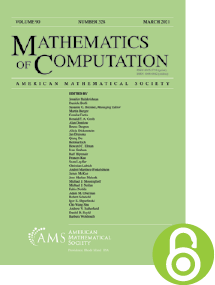A note on Gaussian twin primes
HTML articles powered by AMS MathViewer
- by Daniel Shanks PDF
- Math. Comp. 14 (1960), 201-203 Request permission
References
- Daniel Shanks, A sieve method for factoring numbers of the form $n^{2}+1$, Math. Tables Aids Comput. 13 (1959), 78–86. MR 105784, DOI 10.1090/S0025-5718-1959-0105784-2 G. H. Hardy & J. E. Littlewood, “Partitio numerorum III: On the expression of a number as a sum of primes,” Acta. Math., v. 44, 1923, p. 42. Daniel Shanks, “On the conjecture of Hardy and Littlewood concerning the number of primes of the form ${n^2} + a$,” Notices, Amer. Math. Soc., v. 6, 1959, p. 417. Abstract 559-52. A forthcoming paper with the same title will give an expanded version of this report. J. W. L. Glaisher, “An enumeration of prime-pairs,” Messenger Math., v. 8, 1878. p. 28-33. The empirical evidence for (1) is much more extensive. D. H. Lehmer has computed $z(N)$ = 183728, $\overline z (N)$ = 183582, and ${z}/{z}(N)$ = 1.0008 for $N = {37.10^6}$. See the review, UMT 3, of D. H. Lehmer, “Tables concerning the distribution of primes up to 37 million,” MTAC, v. 13, 1959, p. 56.
Additional Information
- © Copyright 1960 American Mathematical Society
- Journal: Math. Comp. 14 (1960), 201-203
- MSC: Primary 10.00
- DOI: https://doi.org/10.1090/S0025-5718-1960-0111724-0
- MathSciNet review: 0111724


